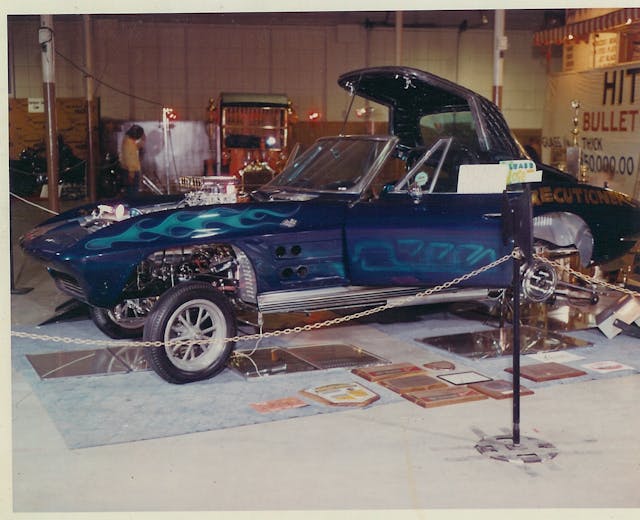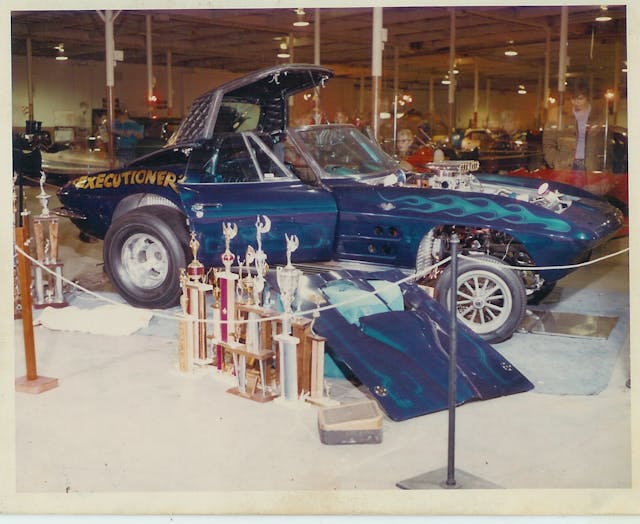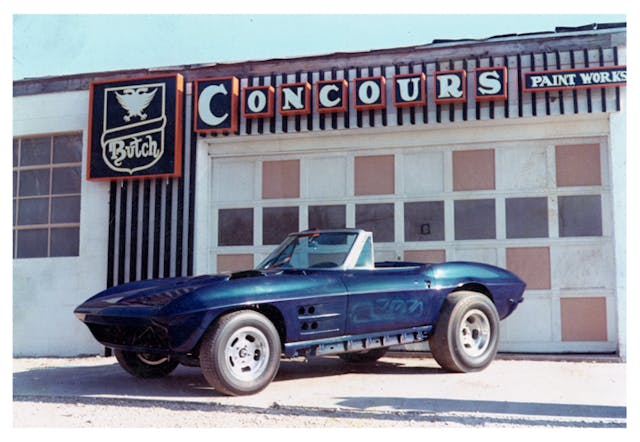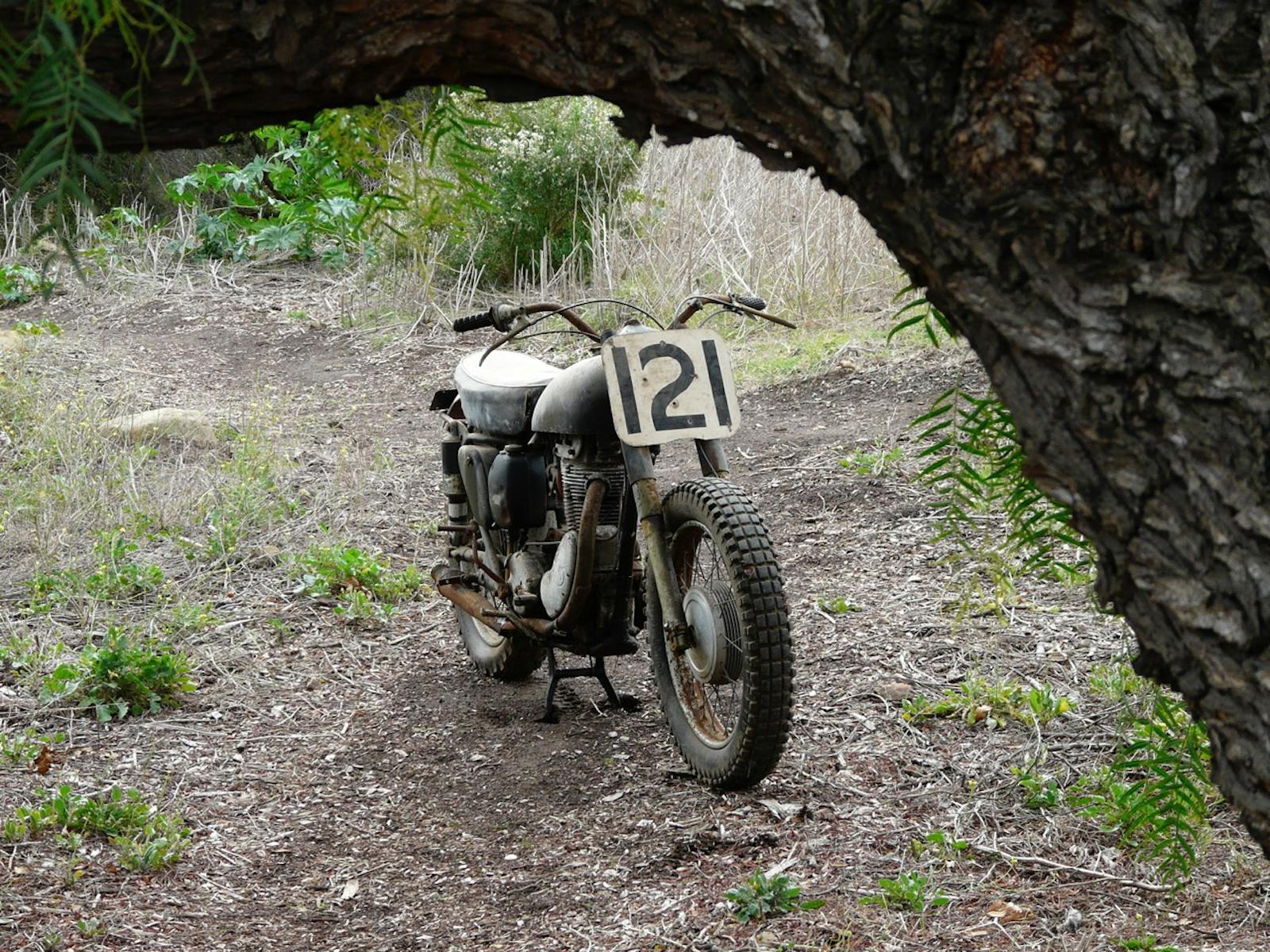How a Medieval Midyear Corvette Killed Our Plan
Wolves howl in the forest while on the hunt. So do car guys when they sense they may make a killing. That could explain why, during the run-up of classic Corvette values in the early 2000s, my friend Scott Young and I bought this 1964 convertible sight unseen. Reportedly built by a Milwaukee enthusiast in 1968, the “Executioner” competed at the strip and in regional International Show Car Association (ISCA) shows. Ultimately, however, the radical customizing turned a low-mileage 300-hp, four-speed Sting Ray into a nearly unsaleable oddity. We just didn’t know it yet.
Popular in the early 1960s, straight-axle drag conversions meant surgically altering the frame, and so began the journey of this genial Daytona Blue roadster into a medieval menace. Sawed off and discarded was the independent front suspension—a real value loss. In showboat tradition, chromed parts included the requisite tubular axle, steering box, and control arms. Revealing the brightwork were 12-spoke American Racing spindle-mount mags. Chrome likewise found the traction bars, the rear transverse spring, the driveshafts and control arms, the wheelie bars, and the push-bar (fashioned like an executioner’s axe).

Over the stock Daytona Blue, Milwaukee painter Butch Brinza applied a candy blue finish, which used fish scales to create a shimmery pop. The Corvette’s original blue vinyl interior ceded to diamond-tufted navy seats, floormats, door panels, and hardtop, which also sported a ventilated Plexiglas backlight. Still more chrome graced the rollbar, fire bottle, and butterfly steering wheel. All in for the win!
The once-mellow 327 had been stroked to 370 cubic inches and wore a chromed side-by-side manifold topped by dual quads and chromed scoops. Early in our stewardship, it vehemently resisted starting; something was afoul with cam and/or ignition timing. You’d swat the pedal and turn the key, and the engine would backfire dramatically. The predicament broke three starter motors, and once, a flame-front bigger than Krakatoa nearly torched the ceiling. Ultimately, a visiting friend requested a 9/16-inch wrench and reset the distributor. Thereafter, the Executioner started fine.

Driving that thing anywhere was another matter. Every couple of miles, the engine surged and stopped, then mulishly refused to restart. Looking back, I suspect the root was a clogged fuel line or filter, a tired pump, a plugged gas-cap vent, or some similarly easy issue. But when you don’t have a clue, you’re clueless. Ultimately, after nursing the Executioner to 20,458 miles, we tapped out. Naturally, selling that car was equally difficult. “We were the only ones who didn’t make money on a Corvette!” Scott joked. Yep, we were those guys.
No wonder—our execution was fatally flawed.
***
Check out the Hagerty Media homepage so you don’t miss a single story, or better yet, bookmark it. To get our best stories delivered right to your inbox, subscribe to our newsletters.



Ah the age of excess.
Many of these cars were never built to drive well. Today the electronics are in place to make the easy to drive.
Also the styling and modifications often were amazing but polarizing. This often led to cars that even won the AMBR award cheap in the back of Hot Rod magazine for sale.
I love it! Straight from the pages of Hot Rod Show World and the ISCA show circuit. Lots of cool there to drool over. Sadly, as Hyperv6 points out, many of those wonderful Street Freaks of yore failed to find a longer running audience. 🙁
Back in the day, very few people foresaw the coming appreciation – both figurative and literal – of C2 Vettes & etc, or sought to preserve them. While cutting them up always bothered me, there seemed to be an essentially endless supply of cars for the guys who liked to heavily modify them to create a personal vision. Some of those cars are an embarrassment now, but at the time were often considered a canvas.
I grew up in Milwaukee. Don’t remember this car. However I remember Butch Brinza’s paint shop. Was located on Ramsey avenue in Cudahy. Some awesome paint jobs came out of there. I recall he eventually moved to California. I think because he was high in demand out there
It’s interesting. How much power did it make at the end?
Butch Brinza painted my Dad’s car the “King’s Coupe” which won the International Grande Champion in the International Show Car Association in the 1978 – 1979 season. The car was based in Milwaukee. The paint was a fade style of paint that went from Candy Tangerine to Candy Apple Red and Gold undercarriage. I knocked a fender off the car (not my fault) and my Dad had to fly Butch in to try and match the paint on the repaired fender.
Well, if we only knew the cars we were beating up, cutting up and throwing away were going to be valuable if cared for, we might’ve cared for them. I might not have driven a literal barn find 1st gen Camaro every day for ten years until it rusted out from under me. On the upside, I drove a barn find 1st generation Camaro every day for ten years.
Precisely. And if everyone had kept the “collectors” they had back in the day in pristine condition, they wouldn’t be interesting or worth much these days, because “everyone would have one. I like Steve’s “canvas” remark – cars like this one were owners expressions of what was cool (feeling not always shared by everyone else!). But to your points, Tinkerah, we didn’t know what we didn’t know – but we sure as heck knew that whatever we had, we should enjoy it in our own way.
if wasn’t a mid year Corvette, a more pedestrian car customized like that would have eventually been stripped for parts and the husk discarded
So it got a straight axle up front. Did the rear stay with the factory IRS?
If so, you had the only car I’ve ever heard of with that combo of suspension. That’s NUTS!
If you had just been able to hang in there, the gasser look has become very popular and the car would now have possibly given you the return you sought.
This is why the National Corvette Restorers Society was formed in 1974. 10 guys in Ohio were concerned about the large number of “America’s Sports Car” that were getting heavily modified. Ironically, 50 years later they have created a Judging category that welcomes modified Corvettes.